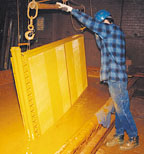Corrosive environments, whether they’re due to processes in a factory or salt water exposure on the East or West Coasts, are extremely tough on evaporators. Even though it costs more to have a coating applied to an evaporator, it can be beneficial in the long run because the evaporator will last longer.
Note: It’s important to make the decision to apply a coating before installation, because it’s next to impossible to accomplish after the evaporator is in place.

Different Types Available
Several types of coatings can be applied to an evaporator. Two of the most popular are modified phenolics and epoxy phenolics.In order to be effective, coatings must be applied at a maximum thickness of 0.003 in. If they’re applied at a greater thickness, the heat transfer rate may be affected.
It’s also important to know that some amount of heat transfer loss occurs when a coating is applied to an evaporator; however, it is normally less than 5%, which remains constant over time. If that small number seems significant, consider that an uncoated, corroded coil will lose much more than 5% in a short time.
Very few coatings can be applied at 0.003 in. or less and still provide good chemical resistance. That’s why the densely cross-linked Heresite heat-cured phenolic is popular.
“Chemical resistance at a thin application is what differentiates a good coil coating from an inferior coating,” says Doug Schmidt, national sales manager, Heresite Protective Coatings Inc., Manitowoc, WI.
“What’s nice about Heresite is that it has a great deal of flexibility as a coating, so that if you bend the fins or whatever, you don’t crack the coating,” says Ken Kaye, sales and engineering manager, Phoenix Division, Super Radiator Coils, Phoenix, AZ.
Kaye says his company also uses a company called Applied Surface Technologies in Louisville, KY, to apply a coating called “ElectroFin” to their evaporators. “Like Heresite, ElectroFin has its own patented process and has a lot of flexibility and resistance to a lot of acids, alkalis, salts, sulfites, and alcohols.”
Sometimes Kaye is called upon to use an epoxy coating for his company’s custom-made evaporators, but that’s primarily for aesthetic purposes (for example, if someone wants a different colored evaporator). But for corrosion resistance, Heresite and Electro-Fin are the industry standards.
How It’s Applied
It is very difficult to apply a coating in the field after the equipment has been installed. That’s because it is next to impossible to spray the coating and get full coverage on all areas of the fins and tubes in field conditions.When a coil needs to be coated, the typical scenario is that the coil manufacturer packs up the coil and sends it to a particular coil-coating facility. There the coil is subjected to rigorous cleaning to get it ready for the coating.
Kaye notes that ElectroFin has a seven-step process it uses to coat evaporators. These steps include an alkaline wash, a city water rinse, and a deionized water rinse. Then the evaporator is dipped in the coating, the excess is sprayed off, and the coil is baked at 400?F. After cooling down, the coil is recrated and shipped to the customer.
“It is very important to cover all surfaces when applying coating to a finned tube coil,” says Schmidt. “The only sure way to do this is to completely submerge the coil in the coating several times. Any method that does not guarantee that all surfaces of the coil are completely covered is incorrect. Surface preparation and cleaning are also very important aspects of a suitable application.”
As you can imagine, it costs more to have the manufacturer ship the evaporator to a coating facility, have the coil coated, then have it shipped to the customer. The additional cost depends on the size of the evaporator, says Kaye. “The smaller it is, the more costly it is, because the setup to do a small coil is almost going to cost you the same as to set up to do a large coil. It can add 50% to the cost of a small coil. For a large coil you might be talking 10% to 25%.”
But that’s nothing compared to the cost of a new coil, says Schmidt. He says that an evaporator dipped in Heresite will prolong the life of a previously uncoated coil in a corrosive atmosphere at least three or four times.
Typically the coating lasts for the life of the coil; it seldom needs to be reapplied. “Normally the coil is operated until the coating and the coil fails, which normally takes many years,” says Schmidt. “Heresite does have an air-dry phenolic touch-up spray available. If it is used as part of normal maintenance, it will prolong the life of the coating and thus the coil.”
Contractors should be aware that effectively applying a coil coating is not an easy task and should be left to those companies with a lot of experience. No matter how chemically resistant the coating is, if the surface preparation is not right or you don’t get full surface coverage, it will likely result in a waste of time and money.
It is also important to have a program of regular maintenance and cleaning, as this will also prolong the life of the coil and its coating. But be aware that some cleaners can damage a coating. For example, high-alkaline cleaners will damage Heresite phenolics. Be sure to check with the coating manufacturer before using any cleaner on a coated coil.
The bottom line is that a chemical-resistant coating expertly applied to a finned-tube coil can add many years to the life of a coil in a corrosive environment.
Publication date: 11/19/2001


Report Abusive Comment